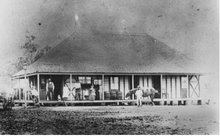Foreshadowing John Howard’s infamous 2001 declaration that “We will decide who comes to this country and the circumstances in which they come,” the government of the colony of Queensland had very clear ideas about the type of migrants they wanted. Money was invested and policies created to select who could come to the colony. In parliament in 1865, it was declared that “If we are to give away our land…we have the right to choose to whom we should give it.”
Appropriate qualities for migrants included strength, youth, high moral standards, willingness to work hard and procreate rapidly and well. Queensland was determined not to take the cast-offs of Britain, Ireland and Europe, but instead to attract willing workers strong enough to survive pioneer life. According to historian Helen Woolcock, assisted passage and land was denied to anyone helped by guardians of the poor or charities as well as discharged military officers who through “previous training and lifestyle [were] poorly prepared for the demands of pioneer life.”
One important criterion was “social solidarity and acceptability”, that is, overwhelmingly Anglo-Saxon. Woolcock describes the notion of a “white man’s land” with coloured labour a “temporary expedient, the Chinese…as hostile invaders, and the aborigines…either ignored or exterminated.”
In 1870 the decision was made by the government to focus efforts on recruiting in agricultural areas of Britain and Europe. Migrant recruitment of young male workers by Queensland was overtaken by the demands of the Franco-Prussian war for these self-same young males. Ports on the Elbe were blockaded and for the period of about a year, direct German-Queensland migration had to be suspended. From 1875 to 1877/78 direct migration from Hamburg to Queensland again took place.
The end result of all this government activism in recruiting migrants was that by 1881, only 40% of the population of Queensland was born in the colony. From 1855 to 1900 the population had soared from not quite 25,000 to close to half a million. (23,520 to 498,249 to be precise). According to Woolcock this was a growth rate six times that of the entire continent of Australia in that period. Most of the migrants were British and the total percentage of “continentals” was about 10%. It is suggested that many of the Europeans came to avoid political unrest rather than just to improve their socio-economic status.
Subscribe to:
Post Comments (Atom)

No comments:
Post a Comment